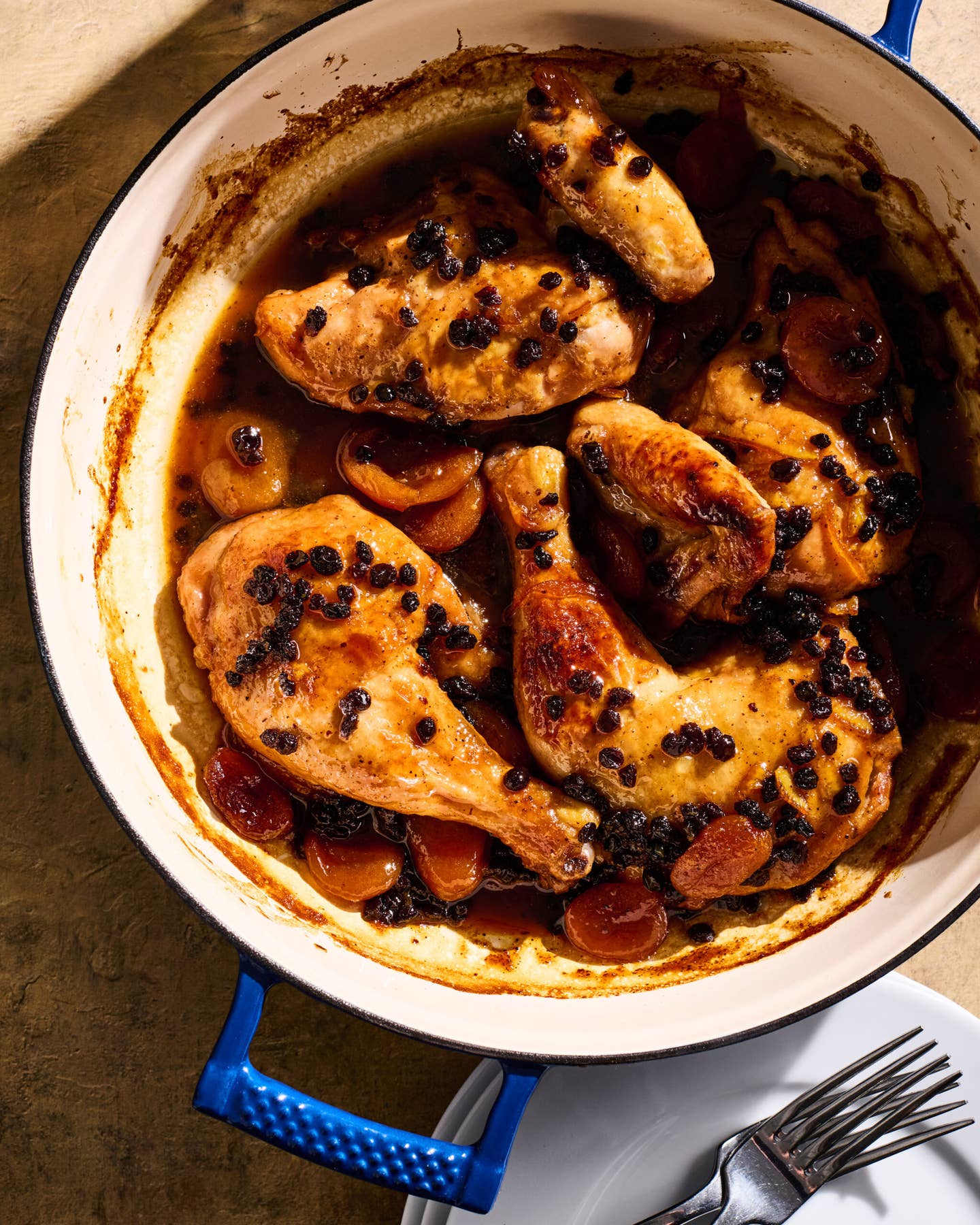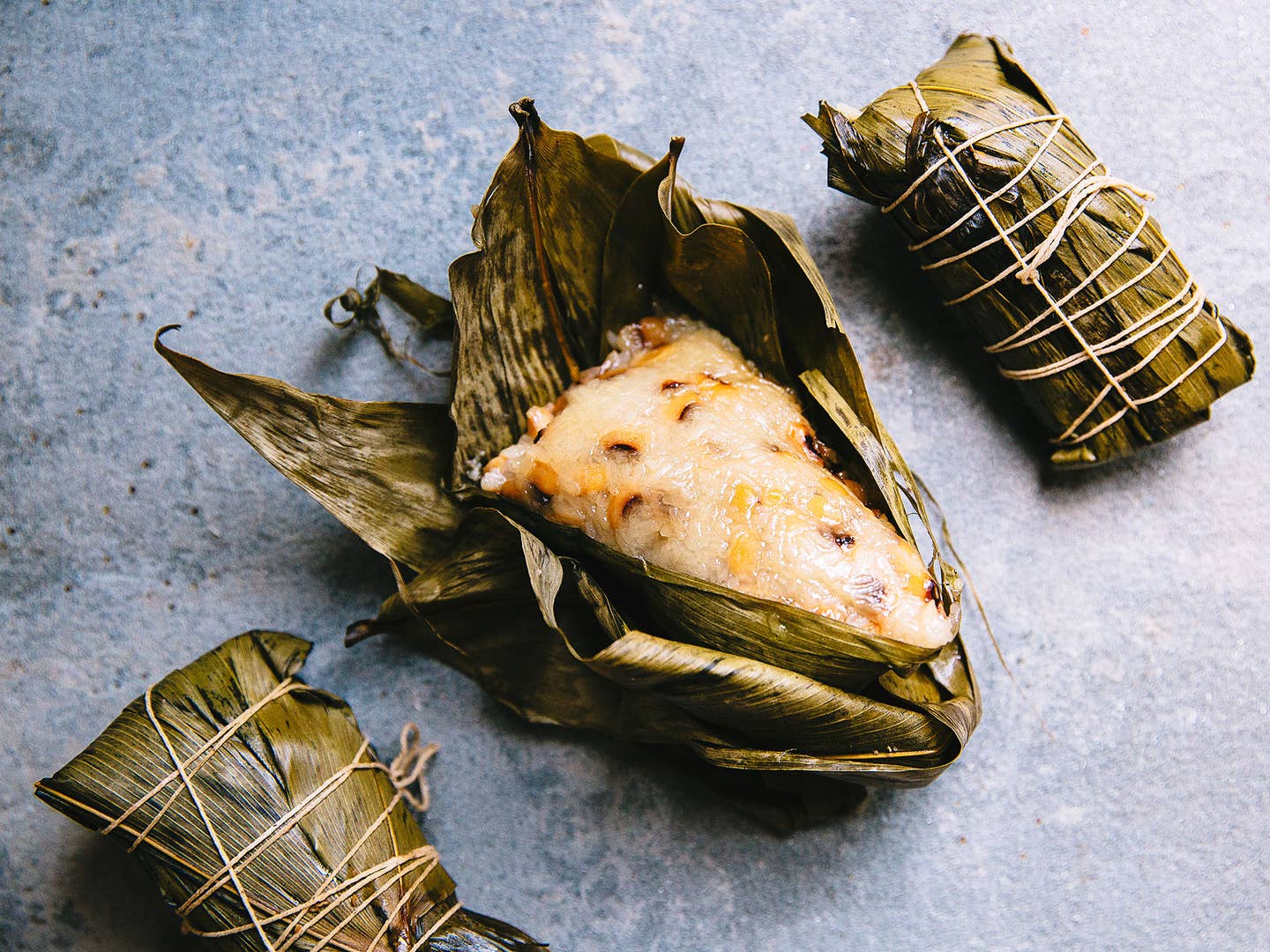
Great Pyramids of China: How to Make Zongzi
A lesson from a Chinese mom on the secrets to perfect bundles of sticky rice stuffed with pork and mushrooms
If you've passed through a well-stocked Chinese grocery store or bakery, particularly in the spring, you've likely seen the tightly-tied leaf-wrapped parcels of sticky rice known as zongzi (TZONG-tzuh, if you're curious). If your Chinese grocery trip took you to the corner of Grand and Chrystie streets in Manhattan's Chinatown, you might have even spotted the Zongzi Lady—the beloved one-woman institution who even has her own Yelp page—selling her perfect, homemade bundles of sticky rice out of a cardboard box propped up on a milk crate.
The Zongzi Lady was my introduction to these Chinese treats, which have a gentle grassy aroma from their bamboo wrappers and are studded with goodies like pork belly and legumes. Unfolding one for a quick snack on the streets of Chinatown is as worthy a New York experience as downing a slice of pizza, and trips to her corner for fresh zongzi have made me hungry to learn all I could about them.
So when my Brooklyn-born Chinese American friend and coworker, Michelle Zeng, showed up to work with a warm bag of what she called her mom’s “Chinese tamales,” as she put it, I could only keep my cool for about five minutes before the fragrant steam of Mama Zeng’s still-warm zongzi made its way across the kitchen.
Once the hoards had receded from Michelle’s bag of treats, I slipped away from my work and snagged one for myself, snipping the carefully tied twine to peel back the leafy wrapping. The bamboo-leaf wrappers released a green, tannic, walnutty perfume that I had never picked up in the Zongzi Lady’s cold rice dumplings.
Inside was a baseball-sized chunk of warm, chewy glutinous rice, generously studded with black-eyed peas, whole peanuts, fatty pork, sliced mushrooms, and sweet-and-salty Chinese sausage. While the Zongzi Lady’s version were tasty and satisfying, they didn’t come close to Mrs. Zeng’s deluxe recipe. I had to learn how to make them.
A Bamboo Tree Grows in Brooklyn
In the 1980s, the Zeng family moved to Brooklyn from Guangdong, where they had worked as farmers. Brooklyn hadn’t been known for its agriculture in over a century, so Michelle’s relatives quickly found work in restaurants in Manhattan’s Chinatown.
Michelle’s mother, Mei, is a formidable home cook, and her Sunset Park basement kitchen—with its ancestral shrine, two vented gas stoves, two fridges, three counters, two sinks, and and two curious cats named Bok Choy and Pickled Vegetable—is more sensibly equipped than many of the restaurants I’ve worked in. When I asked Michelle if her mom would teach me to make her delicious zongzi, Mei happily agreed.
Michelle tells me that Mei’s English is limited to a few pleasantries, but if you walk into just about any restaurant kitchen in the country, you’ll see how insignificant a language barrier can be. Over the course of several hours, Mei gave me a master class in zongzi-making with gestures and quick responses alone.
When I arrived, her mise en place was set tidily in large bowls: a heaping mound of pre-soaked rice, beans, and peanuts; smaller dishes of mushrooms, pork, and sausage; and a tall bucket of damp bamboo reeds. The ingredients in the rice mixture had been soaked separately, rinsed, then mixed together earlier in the day to even out their differing cook-times, and the brittle dried leaves had been soaked for several days to soften them for elaborate folding and tying.
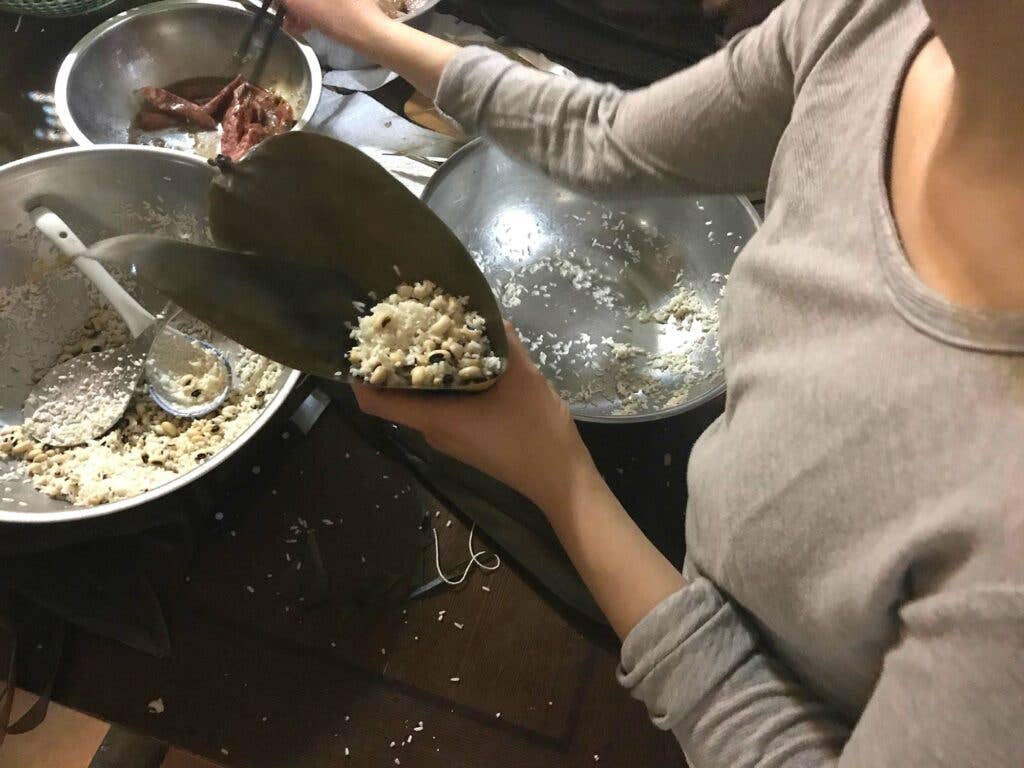
Mei quickly demonstrated how to shape the first dumpling: She chose two broad, unbroken leaves, gripped them together, and flicked them gingerly into a broad cone-shape. She then dropped a scoop of the rice mixture into the cone, followed by a few pieces of pork, mushroom, and sausage, and finally another scoop of rice. Mei then wrapped a third leaf around the front of the cone and folded the front of the bundle down over the filling, tapped the side to pack the mixture into the bottom, and folded the top of the leaves down to to create a tidy triangular dumpling.
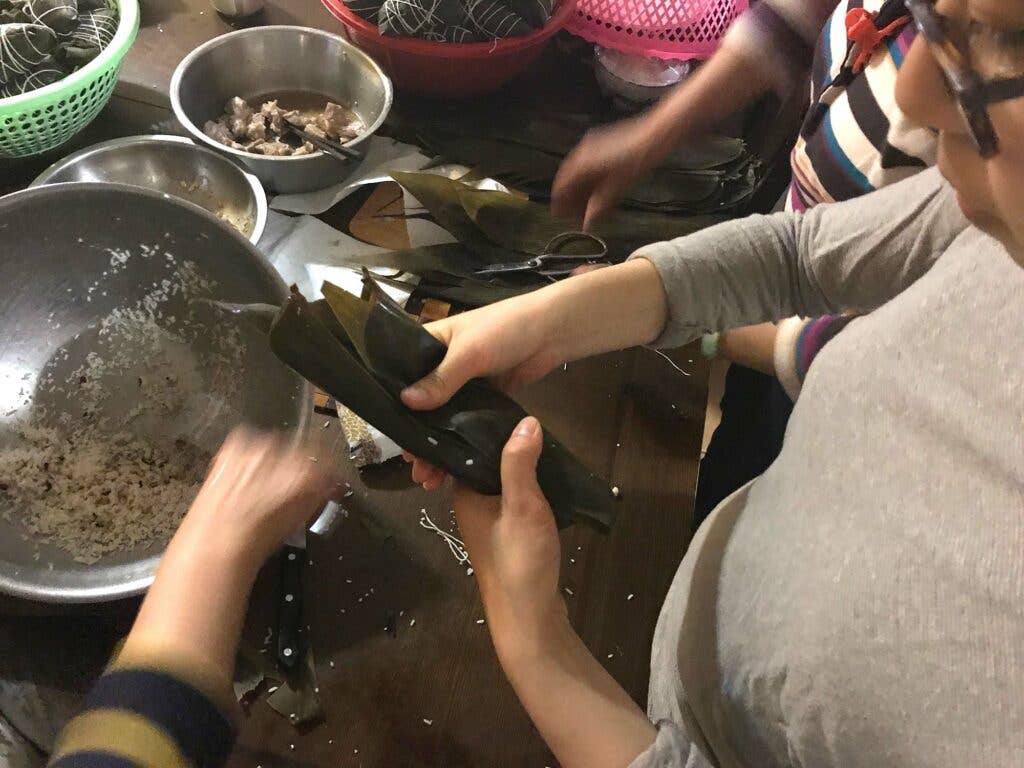
With a few quick twists of kitchen twine and a slight flourish, Mei finished her first zongzi. As she dangled it from its tail for a photo, I marveled and exclaimed, "Beautiful!" and Mei and her onlooking sister erupted in peals of laughter that ebbed and flowed for the remainder of my lesson, while my normally nimble bakers' hands fumbled clumsily through the first dozen or so disheveled dumplings. Lesson one of zongzi: resign yourself to a lot of practice.
Dragon Boat Cuisine
Fold the tops of the leaves over the bundle to form a neat tetrahedron pouch. Then wrap the bundle in kitchen twine and tie a few knots to secure it.
Zongzi are commonly eaten during the weeks surrounding the Dragon Boat Festival, a holiday also known as the Double Fifth Festival, that takes place on the fifth day of the fifth month of the lunar calendar and celebrates the life and death Qu Yuan, the ancient poet and political advisor.
So the story goes, Qu Yuan was banished for speaking out against an alliance between his home state of Chu and the neighboring state of Qin. Years later, when Qin invaded the Chu capital city, Qu Yuan committed suicide by throwing himself in the Miluo river.
His neighbors, who loved and respected him, rushed into the river to try and save him. And when they realized they couldn’t reach him in time, they sprinkled rice into the water to distract the fish from feasting on the poet’s body. Qu Yuan’s legendary fealty and patriotism earned him lasting reverence and admiration amongst his countrymen, which has lasted millennia and spread across China, Taiwan, Singapore, and Malaysia.
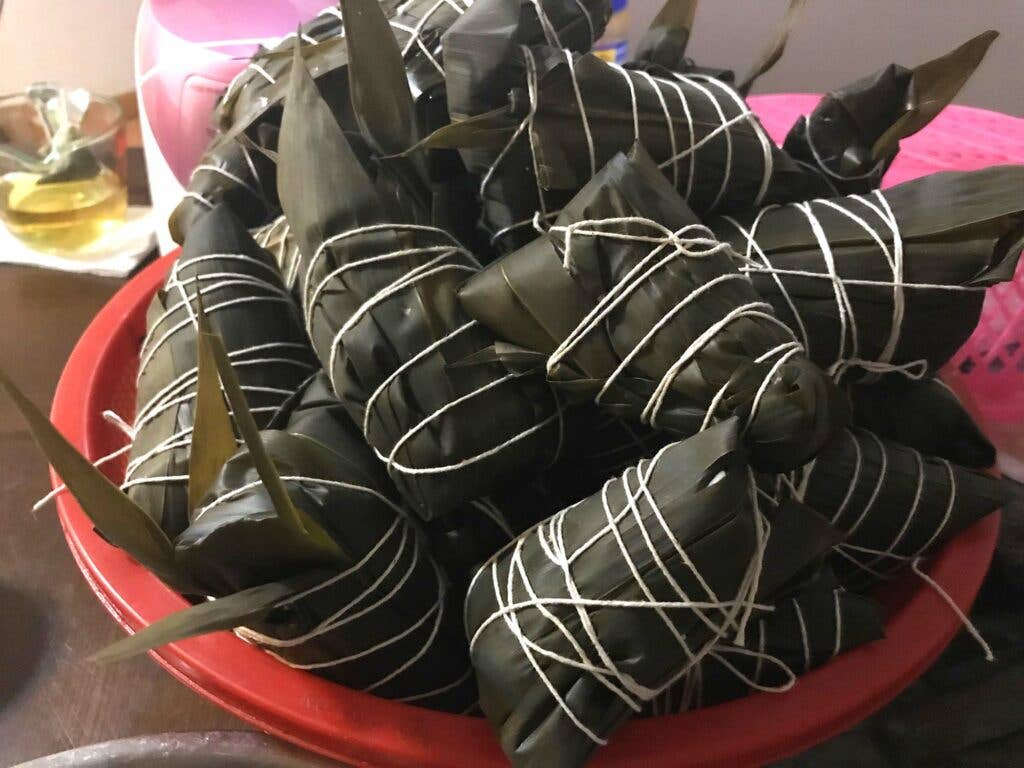
Today, Chinese communities around the world celebrate the Dragon Boat festival with elaborate river boat races and sticky rice dumplings meant to symbolize Qu Yuan’s demise. While zongzi are popular and readily available year-round, they remain closely linked to the holiday, and in the weeks leading up to it, families gather to assemble big batches of their own.
In the northern parts of China, the dumplings are most commonly prepared as sweets stuffed with peanuts and jujubes (small, spongy Chinese dates), while in the south, revelers enjoy savory sticky rice dumplings like Mei Zeng’s recipe, instead flavoring them with fatty pork, bacon, sausage, preserved egg yolks, and mushrooms.
Chef Qilong Zhao of the East Village's MáLà Project will be running both sweet and savory zongzi as a special in the weeks surrounding the festival (it falls on May 30th of this year). If you're interested in making your own and aren't lucky enough to find a Chinese mom to take you under her wing, Zhao is also offering a workshop on shaping and tying the little packets—certainly the trickiest part of the recipe.
When you’re ready to make your own zongzi, give yourself ample time prepare your ingredients. Beyond the long cooking time for simmering the folded dumplings, the bamboo leaves should be soaked in cold water for 24 hours at least, but Mei prefers to give them a few days. It’s also wise to purchase extra leaves, since they have a tendency to split along their center vein, and broken leaves make for messy, awkward dumplings.
Dried chinese sausage, bamboo leaves, sticky rice, dried shiitake mushrooms, and raw peanuts can be found in most Chinese grocery stores, but if you don't have a large Chinese community near you, many of the ingredients can be found at your typical grocery store, and the rest are available online.
If you’re persistent and don’t mind giving your hands a few hours to learn the motions, give Mei’s recipe a shot. The Zeng family likes their zongzi with lots of chunks, but don’t feel like you need to use every ingredient in your first batch. Leave out the beans and peanuts for a simpler dumpling, or nix the pork and sausage in favor of extra mushrooms for a vegetarian version.
With a bit of advance prep and a healthy dose of patience, zongzi are a fun family project—and a delicious way to participate in an ancient Chinese tradition.
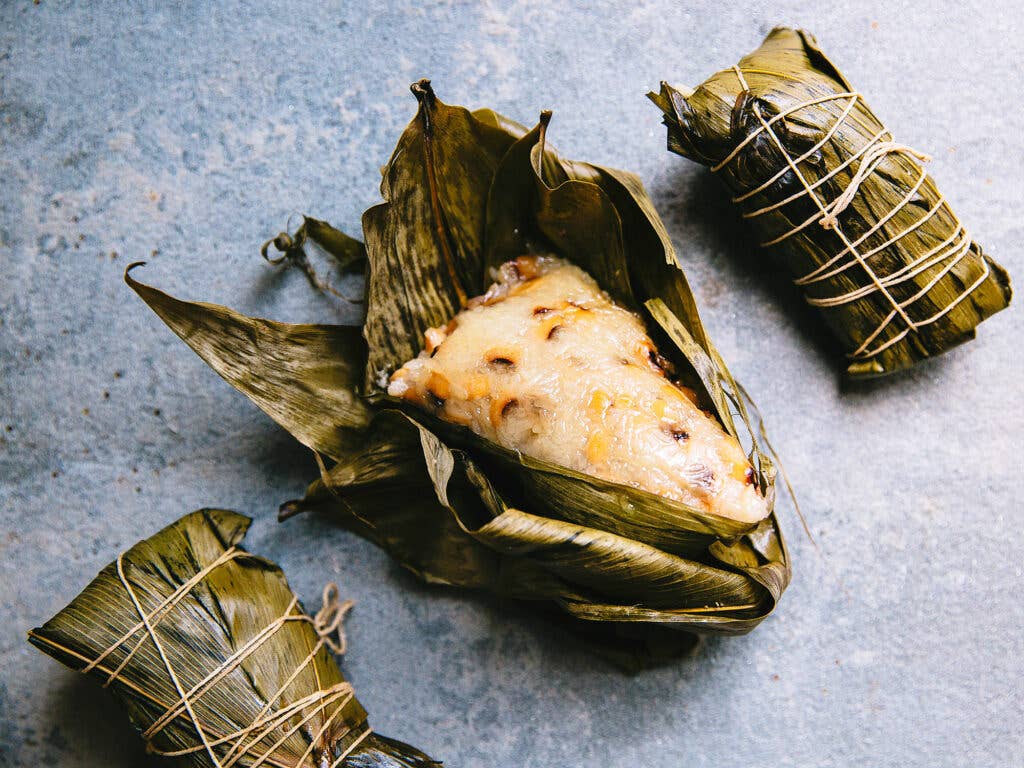
Keep Reading
Continue to Next Story









